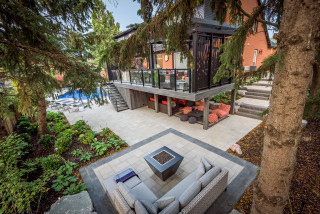
This article was originally published by a www.houzz.com . Read the Original article here. .

This article was originally published by a www.houzz.com . Read the Original article here. .

Look closely at the left side of this photo, where the original siding meets the new fiber cement siding, to see a thoughtful detail. The new siding juts out from the rest of the facade. “This added a thickness and clearly defined the entry and the area underneath the deck,” Shoup says.
This is an “upside-down” house, meaning the bedrooms are on the ground floor, and the living room opens onto the deck. The deck also can be viewed from the kitchen, as the floor plan is open. It’s easy for the homeowners to pour themselves a cup of coffee in the morning and then enjoy it outside among the tree canopies.
This article was originally published by a www.houzz.com . Read the Original article here. .
The “before” photo of this Seattle under-deck area shows how it was a hodgepodge of clutter. The homeowners wanted to create plenty of room where their young children could play, as well as space for dining and lounging.
Landscape designer Rebekah Rongo of SCJ Studio Landscape Architecture answered the call, and a sheltered area that wraps around a corner is part of the result. It’s designed for the kids, with a picnic table on one side, two bright red chairs on the other and a wraparound concrete step connecting the two. Tight-knot western red cedar walls warm up the space, create continuity in the yard’s design and conceal an easy-to-access storage area.
Note the light-colored under-decking too, to ensure that the spaces below stay dry on Seattle’s frequent drizzly days. Any water can drain through the permeable patio paver joints. After this photo was taken, the homeowners added a projection screen under the deck for movie nights.
Read more about this project